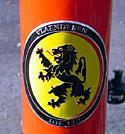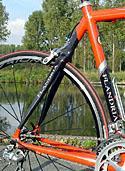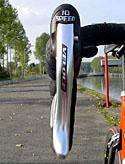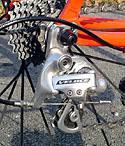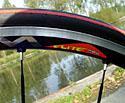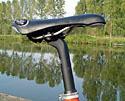
Recently on Cyclingnews.com |
Tech review - November 30, 2004
On test: Flandria CSS-1
Old name, new look
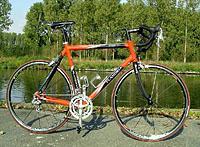
|
Flandria is a historic name in cycling, but the brand has only been available again to the general public for the last two years. After a 21 year hiatus, it was relaunched in 2002 by a British company, and now produces three distinct frame types. Cyclingnews Chief Online Editor Jeff Jones took the Flandria aluminium/carbon CSS-1 for a test ride on the Belgian roads near his seasonal base in Gent, to see whether it lived up to its reputation of old.
Flandria's History
The Flandria Bicycle Manufacturing Company was founded by Belgian brothers Aimé and Remi Claeys in the early 1950s, capitalising on the post-war boom of bicycles and mopeds, which were the most viable means of transport at the time. But Aimé and Remi couldn't agree about the direction of their business, and eventually separated to become competitors. They did so by building a brick wall down the centre of the Flandria factory in Zedelgem! Aimé kept the Flandria name and Remi created a new brand, Superior, both brothers producing essentially the same goods under the same roof.
Flandria became a very popular brand and sponsored a pro team in the 1960s and '70s, which was one of the most successful teams in history. At its peak in the mid-1970s Flandria boasted Freddy Maertens, Michel Pollentier and Marc Demeyer in its ranks. Other top professionals to wear the red Flandria colours during their careers include Rik Van Looy, Roger and Erik De Vlaeminck, Walter Godefroot, Jean-Pierre Monsere, Johan De Muynck, Joop Zoetemelk, Herman Van Springel, and Sean Kelly, who began his professional career with the team in 1977.
While riding for Flandria, these riders won most of cycling's important races: World Road Championship, Giro d'Italia, Vuelta a España, Tour of Flanders, Paris-Roubaix, Liege-Bastogne-Liege, Amstel Gold Race, Championship of Zurich, Paris-Tours, Het Volk, Gent-Wevelgem, Flèche Wallonne, Paris-Nice and Dauphiné Libéré. Only the overall victory in the Tour de France eluded them, although Joop Zoetemelk did record two second places in the Tour while riding for Flandria.
In spite of all this success, the Flandria company went bankrupt in 1981 after the moped side of the business collapsed. Over 20 years later, a British company relaunched the brand, focusing exclusively on bicycles and frame manufacture. It's perhaps a little odd that Flandria bikes are now made in Great Britain, but the company intends to keep the flavour and quality of the originals intact.
Test bike
Flandria currently makes three different frame models, which can be bought separately or made up into complete bikes: CSS-1 (Carbon seat stay), FCS-1 (Full carbon stays) and C Six (All carbon tubes). Cyclingnews tested the bottom of the range Flandria CSS-1 frame, which was specced with Campagnolo Veloce 10 speed, Mavic Ksyrium Elite wheels, ITM bars and stem, and Selle San Marco Era saddle. The claimed weight of this setup was a tad under 8.5 kg and cost €2,102, not including a pair of my own Time Impact pedals.
The all-important frame colour was Flandria red with black highlights - just like the Flandria of old. With the black and yellow Lion of Flanders logo rampant on the head tube, I found the overall effect to be quite pleasing. In fact the logo (Vlaenderen - De Leu), which is written in archaic Flemish, attracted quite a few comments from my Flemish training buddies, most of whom were around when the original Flandria was in existence.
The frame
The CSS-1 is constructed mostly out of Aluton 2 Alu 7005 tubing, with Carbonite carbon fibre S-bend seat stays, which are bonded neatly to the rear triangle. The frame also comes with Carbonite H.M. alloy steerer carbon fibre front forks, which are standard on all Flandria bikes. The added carbon bits in the rear triangle and the forks are designed to dampen road shock and provide a more comfortable ride compared with solid aluminium, which has a reputation of being fairly unforgiving.
There are currently four frame sizes available: S, M, L and XL. Our model was an XL, measuring 58cm (effective top tube length, because the top tube slopes) x 59cm (seat tube height). The S size measures 51cm x 53cm, so shorter and taller riders may have a difficult time finding a frame size that suits them. The seat and head tube angles for the XL are fairly standard: 73 and 73.5 degrees respectively.
Components
The CSS-1 came with equipped with Campagnolo's Veloce 10 Speed groupset, which falls below Record, Chorus and Centaur in the Campagnolo hierarchy. It looks (and is) a bit cheap compared to those ensembles, but it works the same way and does the job well. 10 speeds too. Phwoar.
I'm ashamed to say it was my first experience using Campagnolo, so it did take a little getting used to after Shimano. Campagnolo Ergopower shifting works by using a thumb lever on the inside of the brake hood to drop down to a smaller cog, and a finger lever nestled behind the main brake lever to change up to a larger cog. Shimano's finger lever does exactly the opposite, so my first few rides were full of little surprises.
The Campagnolo thumb lever allows you to shift down several gears at once, unlike the Shimano system. This has its advantages, although I often found myself changing down two gears rather than one because the shifting mechanism was a little stiff. It's great for making that massive attack when you change down from the 53x19 to the 12 in one fell swoop and leave the rest of the bunch trailing in your wake. [Note to self: Must develop enough power to make such massive attacks].
Conversely, Campagnolo's smaller finger lever to change up gears doesn't quite give you the same mechanical advantage as Shimano's all-in-one brake/gear lever. This isn't such a problem on the rear sprockets, but changing from the small to the big chainring at the front required a bit more effort: I often needed two shifts.
Veloce's front and rear brakes are both dual pivot, and use brake pads made out of the same compound as used for Record. They work well in the wet or dry, and gave me that all-important feeling of being able to stop quickly while maintaining total control of the bike.
Finishing kit
Besides the Veloce groupset, the rest of the components were Mavic, Michelin, ITM and Aluton. The wheels were Mavic's tried and trusted Ksyrium Elites. Although not the lightest nor the most aero wheels out there, the Ksyriums are very good all-round wheels. They are stiff, bullet-proof, handle well in the wind and are relatively quick. I consider them a little too stiff for cobbles or really rough roads, and I did find riding over the cobbles at Mater or up the Koppenberg to be an even more traumatic experience than normal.
The Ksyriums came with Michelin IronMan tyres, which are based on the popular Pro Race tyres but aimed at the triathlon market. Weighing 220g apiece, the Ironmans are moderately light all-round racing tyres that perform well in the dry and more than adequately in the wet. Most importantly, they were red and black - matching the colours of the frame.
The handlebars were ITM Super 330 (44cm), which have a deep 17.8 cm drop and an 11.2 cm reach. The drop was no problem for me, although I usually ride slightly narrower handlebars. The stem was an ITM Road Racing alloy model (12cm). The bar/stem combination weighs approximately 530 grams.
Finally, the seating area consisted of a Selle San Marco Era saddle (240g) mounted on an Aluton Alloy seatpost (315g). Again, not a super lightweight combination but one that will do the job. Personally, I have had some painful experiences with saddles that have embroidery on them. The Era may have been comfortable had it not been for its two elliptical shaped embroidered logos that threatened to leave permanent scars on my cheeks. I persisted for a while, but eventually changed the saddle to a Saddleco Flow.
On the road
The Flandria CSS-1 was one of those rare bikes that I could jump on and comfortable on almost straight away, and I did about 2,000 km on it all up. It was very little hassle adapting to slightly shorter cranks and slightly wider handlebars and I could settle back and enjoy the ride. As with most new bikes, I felt like I was going faster on it. The stiffness of the frame/wheels and the crispness of the gear changes certainly contributed to this. It was nice to ride a bike where everything worked properly all at once, rather than being in a steady state of constantly wearing out and replacing parts, or simply putting up with an 80% functionality of certain parts.
The good thing about the Flandria was that I was actually riding faster on it. I managed to equal or better all of my training "records" on climbs or on my regular flat training loops. It was good for sprinting on, and I found it to be more than adequate for descending the small climbs near where I live. Unfortunately, I didn't get an opportunity to race on it as it was the wrong end of the season. But training was nevertheless enjoyable.
In terms of handling, the Flandria was quite responsive - perhaps even a little twitchy occasionally. One thing I did notice was that it was no more comfortable than my aluminium GT on longer rides, and I could feel it in my lower back. It may be that the stiffer Ksyrium wheels more than offset any damping effect of the carbon seat stays and fork. As mentioned above, my attempts to take it across some of the famed cobbled roads in Flanders were not spectacularly successful. It was fine on cobbled climbs where the cobbles weren't too uneven and lumpy, but on something like the Koppenberg I struggled, even using the 39x25.
Obviously I'm a wuss and not a true Flandrian, because I doubt the word "comfort" exists in a Flandrian's vocabulary. If Briek Schotte rode this bike, he wouldn't complain.
Conclusion
For a middle of the range road bike, the Flandria CSS-1 is a solid performer. It feels fast and responsive, and the Campagnolo Veloce does the job. After 2,000 km of Belgian roads, I didn't experience any major wear and tear problems, but that is to be expected. A set of more forgiving wheels and a better saddle would help in the comfort stakes if you are doing a lot of riding on rough roads. Furthermore, with a €2100 price tag, this bike is good value for money.
Pro: Fast and responsive; value for money
Con: Ride was a little harsh; lack of frame size choice
Cyclingnews Rating: ![]()
Full specification: Flandria CSS-1Frame: CSS-1 Flandria Red (Aluton 2 Alu 7005 tubing, Carbonite
carbon fibre seat stays) Cranks: Campagnolo Veloce 172.5mm, 53/39 More information: Flandria's website |
RRP (complete bike): €2,102; (frame only): €850Wheels: Mavic Ksyrium Elite Stem: ITM Road Racing (12 cm) Pedals: Not included |

